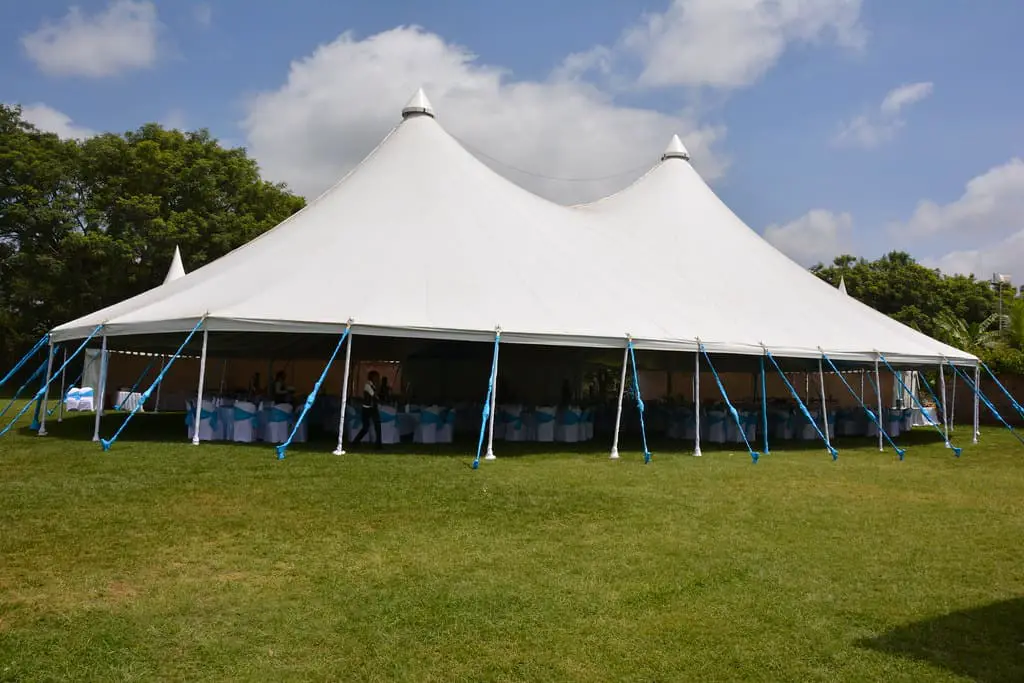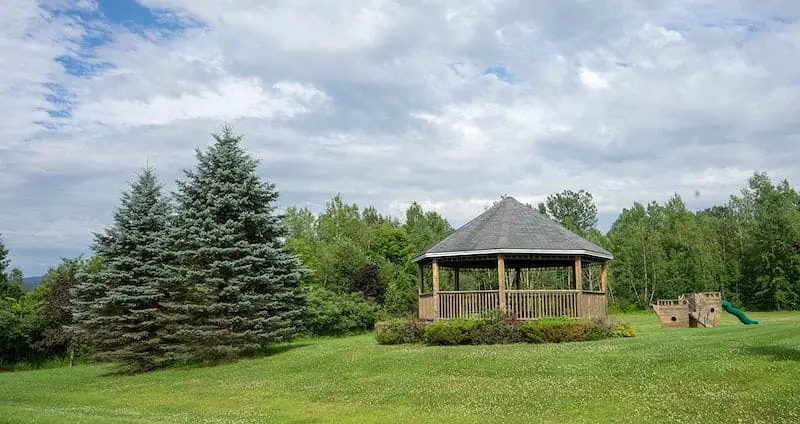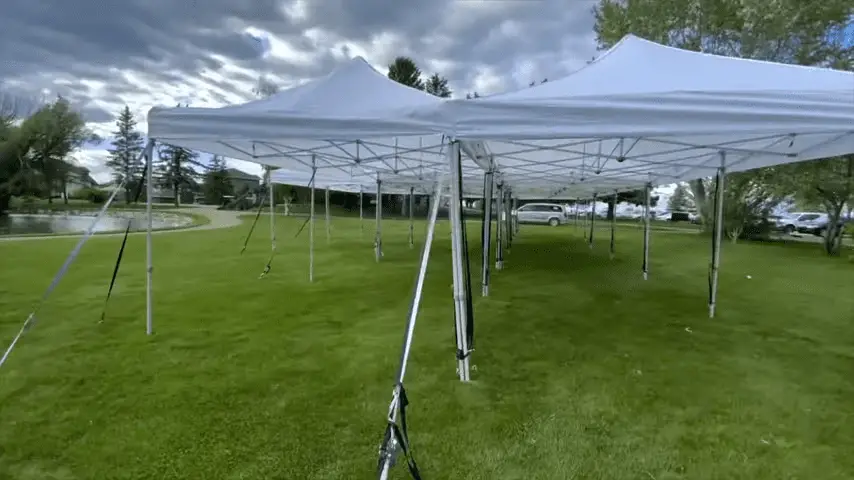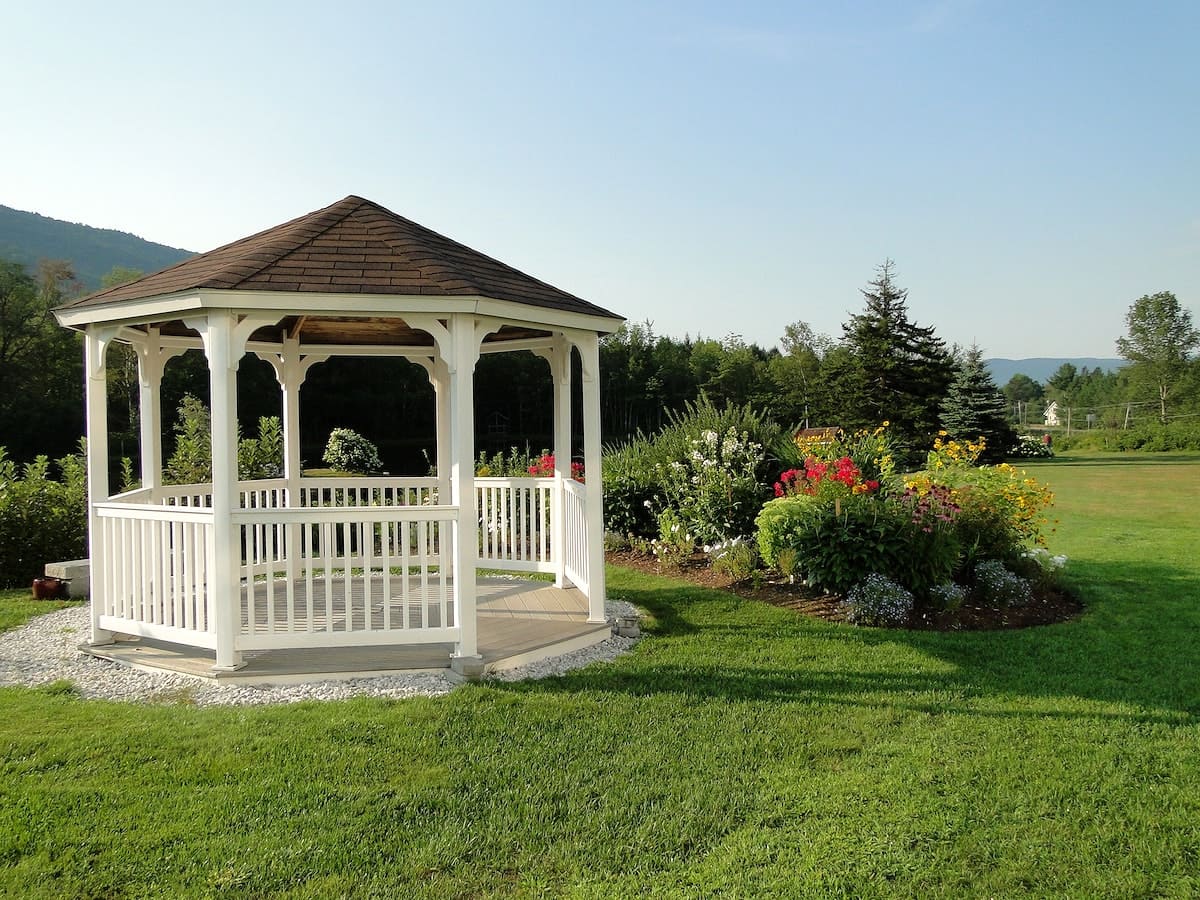A gazebo is an outdoor structure that provides shade and shelter from the sun, rain, and wind. They come in various shapes and sizes, from small pop-up models to larger, more permanent structures.
However, one of the most important considerations when purchasing a gazebo is its ability to withstand wind. Strong winds can cause damage to a gazebo or even make it completely collapse, which can be dangerous for people who are inside or nearby.
Therefore, it is crucial to understand how much wind a gazebo can withstand before making a purchase or setting one up. In this article, we will explore the factors that determine a gazebo’s wind resistance, wind speed ratings for gazebos, and tips to increase a gazebo’s wind resistance.
How Much Wind Can A Gazebo Withstand: A gazebo’s wind resistance depends on several factors such as its shape, size, design, and anchoring. Gazebo wind speed ratings typically range from 25 mph to 80 mph or higher, with some gazebos capable of withstanding hurricane-force winds.
However, it’s important to note that wind resistance can vary based on location and exposure to wind, and customers should always follow proper anchoring and safety measures to prevent potential damage or injury during high wind events.
Definition of a Gazebo
A gazebo is a freestanding outdoor structure with a roof and open sides. It is typically found in gardens, parks, and other outdoor spaces, and is designed to provide shade and shelter from the sun, rain, and wind.
Gazebos come in various shapes and sizes, from small and portable to large and permanent, and may be made from materials such as wood, metal, or vinyl. They are often used as gathering places for outdoor events such as weddings, picnics, and parties, or as quiet retreats for relaxation and meditation.
Importance of Wind Resistance in Gazebos
The wind resistance of a gazebo is crucial because it determines the structure’s ability to withstand strong winds and gusts. High winds can cause damage to a gazebo or even make it collapse, which can be dangerous for people who are inside or nearby.
A gazebo with good wind resistance is also more likely to last longer and require less maintenance than a gazebo that is easily damaged by wind. Therefore, understanding the wind resistance of a gazebo is essential when purchasing or setting up one in an outdoor space.
What Wind Speeds Can Gazebos Withstand?
The amount of wind your gazebo can handle depends on how strong and sturdy it is, as well as how well it is secured. Heavy-duty gazebos are usually able to withstand wind speeds of up to 50-55 kph (31-34 mph) if they are properly secured.
Some permanent gazebos can handle even stronger winds, so think about this when you are choosing which gazebo to buy.
How much wind can a gazebo withstand-guide

Gazebos are popular outdoor structures that can provide shelter and relaxation in various weather conditions. However, they can be vulnerable to wind damage, which can cause structural issues or even collapse.
The maximum wind load that a gazebo can withstand depends on various factors such as its size, design, materials, and location. Checking the manufacturer’s specifications for wind ratings and evaluating the gazebo’s design and materials can help estimate its wind resistance.
In addition, considering the wind zone and location, assessing wind speed and direction, and taking necessary precautions during high wind conditions can help reduce the risk of damage. Understanding how much wind a gazebo can withstand is crucial to ensure its safety and longevity.
Tips for Securing Your Gazebo in Windy Conditions
If you’re using your gazebo in windy conditions, it’s important to secure it properly to prevent any damage. There are several ways to do this:
Ropes and tent pegs:

Ropes and tent pegs are a common and easy way to secure a gazebo in windy conditions. The pegs are hammered through the holes in the gazebo’s feet and into the ground, providing a solid anchor.
The ropes are then attached to the canopy and frame of the gazebo, creating tension and keeping the structure stable. This method is particularly useful for grassy areas or other soft surfaces where the pegs can be easily driven into the ground.
However, it may not be as effective on harder surfaces like concrete where the pegs cannot be used.
Weights:
Weights are a great way to secure your gazebo against strong winds, especially when you are unable to use ropes and pegs. Simply tie the weights or sandbags to the legs of your gazebo to keep it in place.
This method is particularly useful for areas where pegs cannot be used, such as on concrete patios or paving. By using weights, you can ensure that your gazebo stays put during windy conditions and prevent any potential damage that may occur.
Storm straps:
Storm straps are a great way to secure gazebos in high-speed winds. These straps are made of polypropylene material with elastic ends that stretch to prevent them from ripping your gazebo.
They provide extra support to the structure and hold it down firmly, even in extreme weather conditions. To use storm straps, simply attach them to the gazebo’s frame and tie them to the ground using stakes or weights.
They work best when used in conjunction with other securing methods, such as ropes and tent pegs. Storm straps are a reliable and effective way to keep your gazebo in place and protect it from damage caused by strong winds.
Bolts:

Bolts are a great way to secure a permanent metal or wooden gazebo to prevent wind damage. This method works especially well on concrete flooring where it’s possible to drill holes. To use this method, you will need to drill holes in the flooring and attach the bolts to the gazebo’s feet.
Once the bolts are in place, use nuts and washers to secure them tightly to the feet. Bolts provide a strong, stable hold, but keep in mind that they require more effort to install and remove than other options like ropes and weights.
Additionally, if your gazebo is not a permanent structure or if you don’t have a solid flooring surface to drill into, bolts may not be the best option for securing your gazebo in windy conditions.
L-Brackets
Some companies use metal strips to hold the top of the gazebo in place. But if it gets windy, the strips might not be enough. To make sure your gazebo stays put, you can add L-brackets made of steel and joint braces to all of the important connections.
If your gazebo has a cloth roof, the rafters might not be strong enough to handle high winds, so you should use joint braces. Use elastic clips to secure the gazebo in place because the wind will push it in certain directions.
If it’s a temporary gazebo, bring it inside if there are strong winds. These tips will help keep your gazebo from tipping or blowing away.
Factors That Determine Wind Resistance of a Gazebo
There are several factors that can determine how well a gazebo can withstand strong winds. These include the gazebo’s shape and design, size and weight, material, anchoring, location, and wind speed and direction.
Shape and Design
The shape and design of a gazebo can play a significant role in its wind resistance. Gazebos with rounded or curved roofs tend to be more aerodynamic and better able to withstand high winds compared to those with flat roofs.
Additionally, the size and weight of the gazebo can impact its stability in windy conditions. Larger and heavier gazebos are generally more stable and less likely to be damaged by wind.
The materials used in the construction of the gazebo, such as metal or high-density polyethylene, can also affect its wind resistance.
Overall, choosing a gazebo with a design that is aerodynamic and sturdy, along with the appropriate size and materials, can greatly enhance its wind resistance.
Size and Weight

The size and weight of a gazebo can also play a significant role in its wind resistance. Generally, larger and heavier gazebos are more stable in windy conditions than smaller and lighter ones. The weight of the gazebo can help to anchor it in place and prevent it from being blown away by strong winds.
However, it’s important to note that a larger and heavier gazebo may require more anchoring to ensure proper stability. Additionally, a gazebo that is too large for its anchoring or site conditions may still be vulnerable to wind damage, even if it is heavy.
Therefore, it’s important to choose a size and weight that is appropriate for the specific site and anchoring method being used.
Material
The material used to construct a gazebo can also have a significant impact on its wind resistance. Materials that are strong and durable, such as metal or high-density polyethylene, are more resistant to wind damage than weaker materials like wood or plastic.
Metal gazebos are particularly sturdy and can withstand strong winds, but they may require additional maintenance to prevent rust and corrosion. High-density polyethylene gazebos are lightweight yet durable and are resistant to fading, cracking, and peeling.
In addition to choosing a durable material, it’s important to select a material that is appropriate for your local climate and weather conditions.
Anchoring
Anchoring is a critical aspect of ensuring the wind resistance of a gazebo. Proper anchoring can prevent the gazebo from toppling over or being damaged during severe weather conditions, keeping you and your property safe.
There are several types of gazebo anchors available, including weight bags, stakes, and concrete anchors. Weight bags can be filled with sand or water and placed around the gazebo legs to add extra weight and stability.
Stakes can be hammered into the ground to hold the gazebo in place, but they may not be as effective on harder surfaces. Concrete anchors are a more permanent solution and can provide excellent stability even in high winds.
It’s important to choose the appropriate anchoring method based on the gazebo size and site conditions and to follow the manufacturer’s instructions for installation.
Location

Location is an important factor that can affect the wind resistance of a gazebo. Placing a gazebo in a sheltered location can help to reduce its exposure to high winds, and therefore increase its stability.
For example, positioning a gazebo near a wall or fence can provide some protection from wind, as can placing it in an area surrounded by trees or other structures. On the other hand, placing a gazebo in an open field or hillside can expose it to stronger winds, which can make it more susceptible to damage.
It’s important to carefully consider the location of your gazebo when setting it up and to choose a site that offers the best possible protection from high winds.
Wind Speed and Direction
Finally, wind speed and direction are the most obvious factors affecting the wind resistance of a gazebo. The higher the wind speed and the more direct the wind is hitting the gazebo, the more likely it is to be damaged or toppled over.
Wind Speed Ratings & Classifications for Gazebos
When it comes to wind speed ratings for gazebos, there are different classifications and ratings based on wind speed that customers should be aware of. The classifications typically include basic, intermediate, and high wind load ratings, with each classification indicating the level of wind resistance for a particular gazebo design.
The ratings based on wind speed usually range from 25 mph up to 80 mph or higher, with some gazebos capable of withstanding even hurricane-force winds. It’s important to note that ratings can vary depending on the gazebo’s design, size, and materials used in its construction, as well as the location and exposure to wind.
Customers should also ensure that they properly anchor their gazebos to enhance their wind resistance, with various anchoring options available depending on the specific gazebo and site conditions.
Boosting Wind Resistance of Gazebos
To increase the wind resistance of a gazebo, there are several tips that can be helpful. First, consider the design of the gazebo, as gazebos with rounded or curved roofs tend to be more aerodynamic and better able to withstand high winds.
Additionally, larger and heavier gazebos are generally more stable in windy conditions. It’s also important to choose materials that are strong and durable, such as metal or high-density polyethylene, as they are more resistant to wind damage.
Proper anchoring is critical, and options include using weight bags, stakes, or concrete anchors depending on the gazebo and site conditions. Additionally, positioning the gazebo in a sheltered location can help reduce its exposure to high winds.
Finally, customers should always take down or secure their gazebos during high wind events to prevent potential damage or injury.
Proper Installation for Wind Resistance of Gazebos
When it comes to wind resistance of gazebos, proper installation is crucial. The first step is to ensure that the gazebo is assembled correctly and securely, following the manufacturer’s instructions.
This includes properly attaching the roof, walls, and other components. Proper anchoring is also important, with various options available depending on the gazebo and site conditions. Weight bags, stakes, or concrete anchors can be used to securely anchor the gazebo to the ground, preventing it from tipping over or being damaged by high winds.
Additionally, the gazebo should be positioned in a sheltered location, away from areas where the wind is likely to be stronger, such as open fields or hillsides. Finally, it’s important to regularly inspect the gazebo and its anchoring to ensure that everything is secure and in good condition.
Maintaining Gazebo Wind Resistance

Regular maintenance is important to ensure the wind resistance of a gazebo. Over time, the anchoring, materials, and structural components of the gazebo can deteriorate and weaken, making it more susceptible to wind damage.
To maintain the gazebo’s wind resistance, it is important to perform regular inspections and maintenance. This includes checking the anchoring, tightening bolts and screws, and repairing or replacing any damaged components.
Keeping the gazebo clean and free of debris is also crucial, as excess weight and debris can compromise the gazebo’s stability in high winds. By performing regular maintenance, you can extend the lifespan of your gazebo and ensure that it remains safe and sturdy even during severe weather conditions.
FAQs
Q.1 What wind is too strong for the gazebo?
Wind can be very damaging to gazebos if they are not secured properly. Professional-grade gazebos are designed to withstand wind gusts of up to 40mph, but garden gazebos are not as sturdy and should not be used at wind speeds of 27mph or higher, according to the manufacturer’s advice. It’s important to check the weather conditions and make sure your gazebo is properly secured to prevent any damage.
Q.2 How do you secure a gazebo in high winds?
If you want to use a gazebo in windy weather, it’s important to make sure it’s properly secured. You can use stakes to keep it in place, or you can use weights like sandbags or water barrels to anchor it down. This will help prevent it from being blown away by the wind.
Q.3 Are gazebos good for the wind?
The bigger the gazebo, the more likely it is to get damaged by wind and weather. On the other hand, smaller gazebos are sturdier and better able to withstand tough weather conditions. For example, a small 3×3 gazebo is stronger than a bigger one and can protect you better from wind and bad weather.
Q.4 Which roof is best for a gazebo?
Asphalt shingles are the most commonly used roofing material for gazebos. You can pick shingle colors that match your house roof. Rubber Slate is a cheaper way to get the look of slate shingles, and it’s easy to install and eco-friendly. Cedar Shake shingles are used to create an elegant and classic gazebo look.
Q.5 What makes a gazebo permanent?
Permanent gazebos are garden structures that are meant to stay in one spot for a long time. They are usually made of wood, plastic, or composite materials and have a roof made of shingles, shakes, or metal. They also have a floor and are held in place to resist wind and bad weather.
Conclusion
In conclusion, determining the wind resistance of a gazebo is essential to ensure its safety and longevity. The amount of wind a gazebo can withstand depends on factors such as its size, design, materials, and location. Checking the manufacturer’s specifications for wind ratings, evaluating the gazebo’s design and materials, and considering the wind zone and location can help estimate its wind resistance.
Assessing wind speed and direction and taking necessary precautions during high wind conditions can reduce the risk of damage to the gazebo. It is crucial to follow manufacturer guidelines and local codes to ensure the gazebo can withstand the wind conditions in the area.
By taking necessary precautions and understanding the factors affecting wind resistance, gazebo owners can enjoy their outdoor structures without worrying about wind damage.
We hope you will be well aware of how much wind can a gazebo withstand by reading this comprehensive guide. If you have any questions, feel free to comment below!

